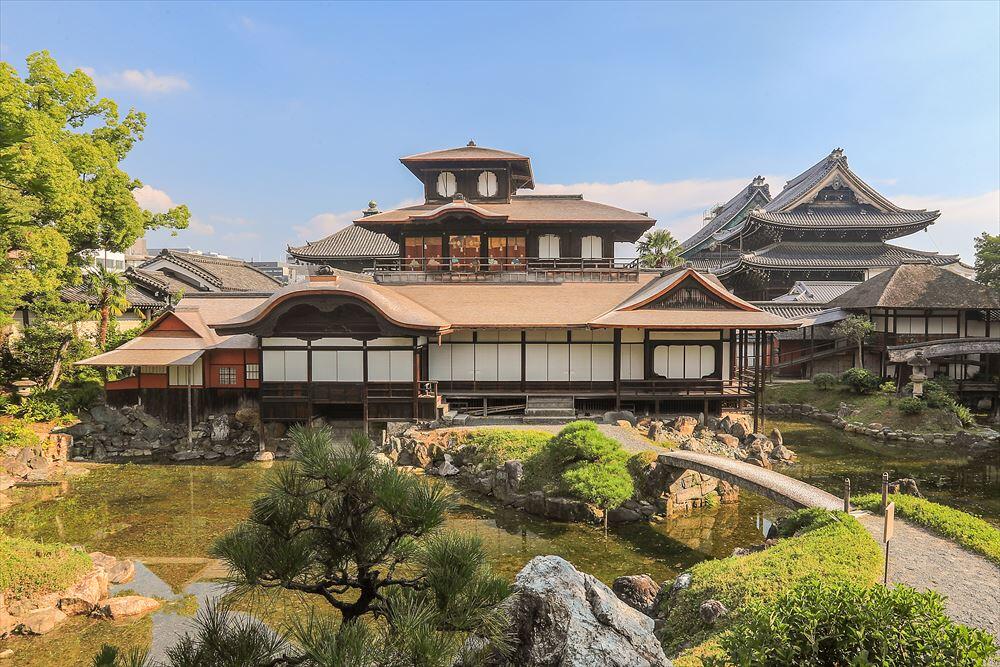音声ガイド_24_飛雲閣
24.飛雲閣(Hiunkaku)

日本語
「飛雲閣」は天正15年、1587年に現在の京都御所と二条城の間付近に豊臣秀吉が建てた聚楽第の一部であったものを、江戸時代前期の寛永9年、1632年に本願寺に移築したものであるとも伝えられています。 令和元年、2019年に屋根を修復しております。金閣・銀閣に並び京都三名閣の一つに数えられ、こけら葺きの三層からなる楼閣建築です。 第一層は、入母屋造り(いりもやづくり)と唐破風造り(からはふづくり)とが左右非対称に配置されており、不規則ながら巧みに調和がとれているところが大変印象的です。また、向かって左側、唐破風の屋根の下には、池に面して石の階段がありますが、移築前、飛雲閣は池の中央に建てられていたといわれ、船を用いて出入りをしていたと伝えられています。そのことから、階段を上がったところを「舟入之間(ふないりのま)」と申します。第二層は色彩豊かな三十六歌仙が描かれていることから、「歌仙之間」といい、この歌仙図は屋根の修復に伴い、復元模写されたものです。第三層の部屋は「摘星楼」と呼ばれ、物見をする部屋として使用されたと伝えられています。 また、「飛雲閣」に向かいまして左側には、江戸時代後期の寛政7年、1795年に増築された茶室「憶昔(いくじゃく)」が付属しております。
中文
24 飛雲閣 據說"飛雲閣"是豐臣秀吉建造的"聚樂第"的一部分。於1587年建於現在的京都御所和二條城附近。後於江戶時代的1632年遷移到了現在的本願寺。 2019年對「飛雲閣」的屋頂進行了修補。 在京都,"金閣"、"銀閣"、"飛雲閣"被稱為京都三大名閣。 飛雲閣是一座以木板屋頂為主的三層樓閣建築。 第一層採用的是歇山頂和博風頂式的屋頂結構,左右非對稱式設計風格,使整體設計上協調一致,而個體設計上又各有千秋。另外,在博風頂下又建了面向池塘的石樓梯。據說飛雲閣在移到本願寺之前曾經是一座建造在池塘之中的樓閣,來去需行舟才行。上樓梯的這一段區域被稱為"舟入之間"。 第二層的木板窗上繪有日本奈良時代和平安時代的三十六位歌仙,色彩豐富,鮮艷奪目,因此被稱作"歌仙之間"。在修復屋頂的時候也曾對這些歌仙圖進行過復原和描畫。 第三層被稱為"摘星樓",是用作欣賞風景的觀景台。 另外,面對"飛雲閣"的左邊是於江戶時代後期的1795年增建的茶室,取名"憶昔"。
한국어
24 히운카쿠 '히운카쿠'는1587년 도요토미 히데요시가 현재의 교토 고쇼와 니조성 사이에세운 주라쿠다이의 일부를 에도시대 전기인 1632년에 혼간지로 이축한 것이라고 전해집니다. 2019년에는 지붕을 수리하였습니다. 금각, 은각과 견줄만한 교토 3대 명각 중의 하나로 손꼽히며 3층으로 구성된 널지붕의 누각건축입니다. 1층은 팔작지붕과 당파풍 스타일의 지붕이 좌우 비대칭으로 배치되어 있으며 불규칙하면서도 교묘하게 조화가 이루어져 있는 것이 매우 인상적입니다. 또한, 건너편 왼쪽의 당파풍 지붕 아래에는 연못을 향해 있는 돌계단이 있는데 이축 전에 히운카쿠는 연못 중앙에 세워져 있었다고 하며 배를 사용하여 출입하였다고 합니다. 따라서 계단 위를 '후나이리노마'라고 합니다. 두번째 층은 36가선이 다양한 색채로 그려져 있어 '가센노마'라고 하며 이 가센도는 지붕 수리 시에 복원 묘사된 것입니다. 세째층 방은 '데키세이로'라고 하여 밖을 구경하는 방으로서 사용되었다고 합니다. 또한, '히운카쿠'를 마주해서 왼쪽에는 에도시대 후기인1795년에 증축된 다실 '이쿠자쿠'가 딸려 있습니다.
English
24 Hiunkaku In addition to the Kinkaku, gold and Ginkaku, silver pavilions, is the Hiunkaku, or Flying Cloud Pavilion which make up what is known as The Three Pavilions of Kyoto. Believed to have once been a section of Toyotomi Hideyoshi's Jurakudai, that stood in the vicinity between the Kyoto Imperial Palace and Nijo Castle in the late 1500s, one legend has it that the Hiunkaku was brought over and reassembled on the Hongwanji grounds in 1632. However, it is most likely that the Hiunkaku was built when the Tekisuien garden was built in the mid-1600s. When the Hiunkaku was said to have been located at the Jurakudai, it was said to have been built surrounded by a moat and the only way to enter the pavilion was by boat. Therefore, based on these legends, the stone steps that can be seen in the pond built just below the structure is known as the boat landing. The Hiunkaku is known for its precisely designed asymmetrical shape and variety of roof styles that harmonize one another. The interior of the first floor is in the shoin style with an alcove, writing shelf, split-level shelves, and decorative screen windows. To the left of the main pavilion structure, a tea room was built as an extension, named Ikujaku, which means reminiscence. Beautifully decorating the panels of the second story are the thirty-six celebrated poets of Japan. Therefore, it is known as the Chamber of Poets. As part of the commemoration activities during the observance of the 500th Memorial of Rennyo Shonin, in 1996, new panels were created and installed. And in 2019, the roof was refurbished. The third floor, with its pyramidal rooftop and wooden panel windows, is called the star-gazing tower. Despite its calming name, it is said to have likely been used as a lookout tower.
Português
24 Hiun-Kaku (Pavilhão da Nuvem Volante) Este Pavilhão de três andares foi construído originalmente como a residência do Shogun Hideyoshi em Jurakudai, o seu palácio no sul de Quioto. Situava numa ilha, e se requeria um barquinho para chegar a este lugar. É considerado que o pavilhão foi transferido ao Hongwanji por volta de mil seiscentos e dez. Os telhados de ripa foram cuidadosamente desenhados, pois o pavilhão era rodeado pela água e era visível de todos os lados. No andar térreo se encontram as salas principais de recepção, incluindo um desembarcadouro e uma casa pequena de cerimônia de chá. No primeiro andar se vê a Sala dos Poetas, que se chama Kasen-no-Ma, e as suas paredes estão adornadas com os retratos dos poetas célebres dos séculos 9 a 11. A torre onde se olham as estrelas está no alto do pavilhão. O telhado do Pavilhão foi reformado em 2019.


